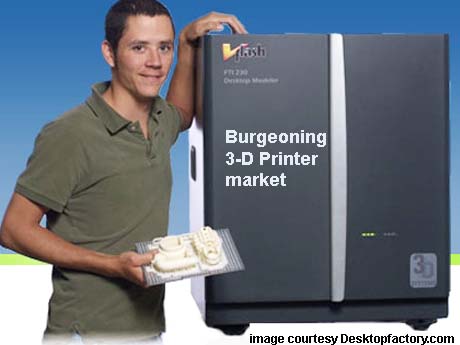
Mumbai, October 8, 2013: “In the last 12 months, India has seen a transformation in the 3D printing industry with the emergence of local 3D printer manufacturers. The country has a very vibrant ‘maker’ community, and many new entrants and hobbyists are developing 3D printer variations based on the open source RepRap initiative, “ says Zalak Shah, research analyst at Gartner. “ In a developing country like India, 3D printing has huge potential and exciting opportunities which are being explored, like remote printing of products and recycling of household plastic waste for feeding the printers.”
3D printing can be extensively used in India because the country has a diverse and growing manufacturing industry that supports a wide range of markets and leverages strong R&D capabilities that are in-country. Also, the potential for cost and time savings, greater capabilities and improved performance could drive the market.
Gartner, Inc.'s first forecast of the less than $100,000 consumer and enterprise 3D printer market, says worldwide shipments of 3D printers (3DPs) priced less than US$100,000 will grow 49 percent in 2013 to reach a total of 56,507 units, driven by enterprise and consumer demand. Shipments will increase further in 2014, growing 75 percent to 98,065 units, followed by a near doubling of unit shipments in 2015, Gartner adds.
In 2013, combined end-user spending on 3DPs will reach US$412 million, up 43 percent from US$288 million in 2012. Enterprise spending will total more than $325 million in 2013, while the consumer segment will reach nearly $87 million. In 2014, spending will increase 62 percent, reaching $669 million, with enterprise spending of $536 million and consumer spending of $133 million.
"The 3D printer market has reached its inflection point," says Pete Basiliere, research director at Gartner. "While still a nascent market, with hype outpacing the technical realities, the speed of development and rise in buyer interest are pressing hardware, software and service providers to offer easier-to-use tools and materials that produce consistently high-quality results. In the next 18 months, we foresee consumers moving from being curious about the technology to finding reasons to justify purchases as price points, applications and functionality become more attractive."
3D printers have historically been sold in small quantities with most of the early additive manufacturing devices sold to the North America, Western Europe and Mature Asia Pacific regions – not coincidentally the countries where the major technology service providers were based. The number of printers that will be sold in these regions outpaces the numbers in the other regions by several hundred thousand units. While the North American and Western European regions have so far dominated the market, Greater China's 98.8 percent CAGR will outstrip them by up to six points by 2017. In mature Asia Pacific countries, shipments of 3D printers are forecast to grow 52.1 percent in 2013 to reach 3,817 units and 70,295 units by 2017; while in emerging Asia Pacific markets, total shipments are expected to grow 55.7 percent to reach 1,643 units in 2013 and reach more than 14,800 units in 2017.
Impact of 3D Printing: Gartner predicts that 3D printing will have a high impact on industries, including consumer products, industrial and manufacturing; a medium impact on construction, education, energy, government, medical products, military, retail, telecommunications, transportation and utilities; and a low impact on banking and financial services and insurance.From an enterprise point of view, current uses of 3D technology focus on one-off or small-run models for product design and industrial prototyping, jigs and fixtures used in manufacturing processes and mass customization of finished goods. As advances in 3D printers, scanners, design tools and materials reduce the cost and complexity of creating 3D printed items, the applications of 3D print technology will continue to expand to include areas such as architecture, defense, medical products and jewelry design.
3D printer prices will decrease during the next several years due to competitive pressures and higher shipment volumes, even after allowing for providers who will be offering devices with higher performance, functionality and quality that enable them to hold the line on pricing. Gartner expects that by 2015, seven of the 50 largest multinational retailers will sell 3D printers through their physical and online stores.
More detailed analysis is available in the report "Forecast: 3D Printers, Worldwide, 2013." The report is a paid document available on Gartner's website
Do see our story on India's own 3-D printer